The total external debt of the least developed countries under the Debt Service Suspension Initiative (DSSI) has increased by 9.55% to $744 billion in 2019.
This was disclosed in the World Bank’s International Debt Statistics 2021 released in Washington D.C. on Monday.
According to the report, the figure was equivalent on average to one-third of the countries’ combined gross national income.
READ: Nigeria total public debt hits N31 trillion as debt service gulp over N1.2 trillion in H1 2020
It stated, “Lending from private creditors was the fastest-growing component of the external debt of DSSI-eligible borrowers, up five-fold since 2010. Obligations to private creditors totaled $102 billion at the end of 2019. The debt stock of DSSI-eligible countries to official bilateral creditors composed mostly of Group of 20 (G-20) countries, reached $178 billion in 2019 and accounted for 27% of the long-term debt stock of low-income countries.”
According to the report, this highlights an urgent need for creditors and borrowers alike to collaborate and stave off the growing risk of sovereign-debt crises triggered by the COVID-19 pandemic.
READ: Nigeria’s total public debt stock increased by N2.381 trillion in 3 months
It added that the pace of debt accumulation for these countries was near twice the rate of other low- and middle-income countries in 2019.
The report said that in response to an urgent need for greater debt transparency, this edition provided more detailed and disaggregated data on external debt than ever before in its nearly 70-year history.
READ: First Bank is cutting inefficiencies and focusing on its strengths
According to the report, details include breakdowns of what each borrowing country owes to official and private creditors in each creditor country and the expected month-by-month debt-service payments owed to them through 2021.
Pre-COVID
The World Bank said that before the onset of the COVID-19 pandemic, rising public debt levels were already a cause for concern, particularly in many of the world’s poorest countries as discussed in its Four Waves of Debt report published in December 2019.
READ: Nigeria’s debt rises to $79.5 billion, as debt to revenue ratio worsens
“Responding to a call from the World Bank and the International Monetary Fund, the G20 endorsed the DSSI in April 2020 to help up to 73 of the poorest countries manage the impact of the COVID-19 pandemic. The debt stock of DSSI-eligible countries to official bilateral creditors, composed by mostly G-20 countries, reached 178 billion dollars in 2019 and accounted for 17% of long-term net debt flows to low and middle-income countries. Within the G-20 creditor group, there have been some important shifts characterized by a marked increase in lending by G-20 member countries that are themselves middle-income countries,” it added.
READ: Nigeria records lowest remittances from abroad since 2008
Citing China as an example, though by far the largest creditor, it had seen its share of the combined debt owed to G-20 countries rise from 45% in 2013 to 63% at the end of 2019.
It said that over the same period, the share for Japan, the second-largest G-20 creditor, had remained broadly the same at 15%.
READ: LCCI condemns Senate over Buhari’s $22.7 billion loan approval






















